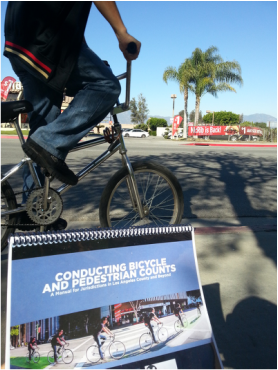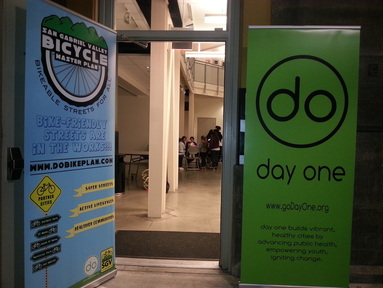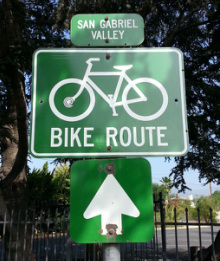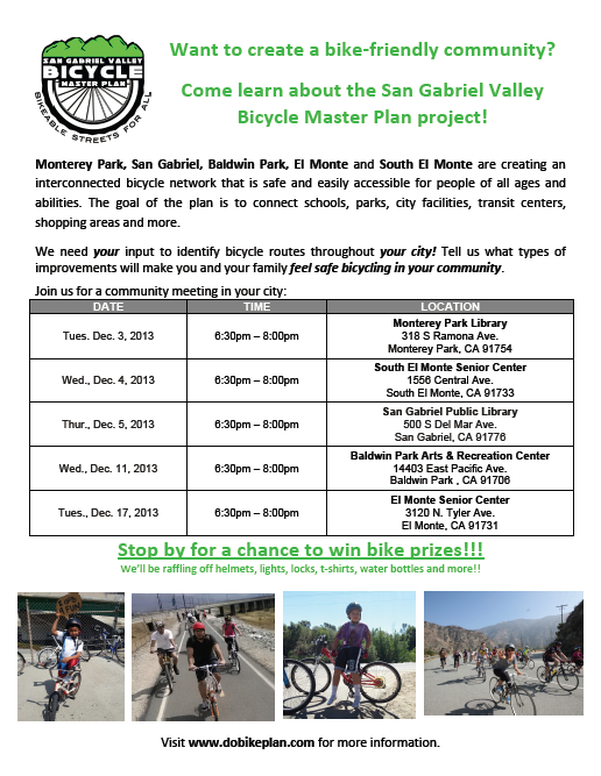|
On Saturday April 5, 2014 a group of Monterey Park students and local residents joined SGV Bike Plan project staff to conduct a community street audit. Traveling by bicycle along a route identified for potential bicycle improvements by community residents at an earlier workshop, participants had the opportunity to experience and document existing conditions along a variety of MPK streets, suggest specific improvements on individual forms, and provide feedback and questions directly to staff. The group stopped at four pre-determined locations, including Mark Keppel High School, to capture notes for each section of the traversed route. One of 5 community audit rides conducted in each project city, the the activity provided an excellent opportunity for a diverse group of residents to learn more about the SGV Bike Plan project and shape the draft plan's recommendations. Many thanks to all the volunteers who made the event a success!
0 Comments
 More often than not, bicyclists and pedestrians are typically not included in traffic counts. According to the Federal Highway Administration, 20% of all trips in LA County are on foot or by bike while 39% of roadway fatalities are pedestrians or bicyclists. Yet, statewide investments in bicycle and pedestrian infrastructure remain less than 1% of the total transportation budget. Conducting bike/ped counts is critical for understanding our complete transportation system especially as investments in efficient, multi-beneficial and affordable modes of transit become more widely prioritized. Bike/ped counts help:
Many cities have recognized the value of biking and walking and have therefore conducted their own respective counts. However, due to varying count methods, the resulting data sets paint a regionally-skewed picture of biking/walking usage and behavior. In 2013, The Southern California Association of Governments (SCAG) and the Metropolitan Transportation Authority (Metro) created and released a standard manual for counting bicyclists and pedestrians. The SGV Bike Master Plan seeks to establish baseline bike/ped data in the San Gabriel Valley to compare across multiple-jurisdictions, especially partnering cities. El Monte and South El Monte were prioritized for counts due to recently approved and soon to be installed bikeways in each city. With 2013 rapidly coming to a close, project staff coordinated the first ever bike/ped counts in the San Gabriel Valley using the new count manual. Thanks to the dedicated Day One family and BikeSGV volunteers, a total of 42 counts, at 16 locations over 6 days plus one day of training was completed. Once the data is cleaned, organized and analyzed a final report will be produced and shared. Many thanks to the many volunteers that sacrificed their early mornings, early evenings and Saturday afternoons to sit street-side counting cyclists and pedestrians (even in the rain). Your support directly influences bike/ped improvements in our beloved SGV.  December 2013 has been a stellar month for the SGV Bike Master Plan. For the first time, residents within the cities of Monterey Park, San Gabriel, Baldwin Park El Monte and South El Monte were afforded opportunities to weigh-in on the development of the San Gabriel Valley Bicycle Master Plan through a series of workshops. Unlike a traditional "sit, listen and watch a powerpoint presentation," the first round of jurisdiction-wide workshops were designed with the goal of optimizing community participation through active engagement. The workshop platform was divided into individual stations that were designed to capture specific feedback from participants. Each station had a different but related theme, which included:
To ensure that the San Gabriel Valley Bicycle Master Plan reflects the wants and needs of local residents and regional stakeholders the project has placed a big emphasis on community feedback. The first draft of the plan is expected to be released in April 2014. Until then, you can surely expect more workshops and opportunities to weigh-in on the future of a bike-able San Gabriel Valley. If you haven't already, please take a moment to explore this website to learn more about the SGV Bike Master Plan. Also, don't forget to complete the General Bicycle Survey and subscribe to the project newsletter to be up-to-date on upcoming events, workshops, bike rides and more.  The San Gabriel Valley Bicycle Master Plan is well underway, and a first round of public meetings is scheduled for the first few weeks of December. The Plan aims to encourage healthy and active lifestyles by creating an interconnected bicycle network that is safe and easily accessible for people of all ages and abilities. However the input and expertise of local residents is needed to ensure the development of a plan that provides safe routes to schools, parks, city facilities, transit centers, business districts and more. In addition to helping shape a more bicycle-friendly SGV, MEETING ATTENDEES WILL HAVE A CHANCE TO WIN PRIZES such as helmets, lights, locks, t-shirts, water bottles and more!!! December Workshops:
December Workshop FlyerThe 2013 California by Bike Summit brought together stewards of the bicycle movement in and beyond Cali to brainstorm ways to mainstream biking, learn about local and regional achievements along with state-wide progress on bicycle-related laws, policies and funding. The amazing biking weather combined with the evident embrace of bicycle infrastructure and programs in Oakland made for a perfect locale for this year's summit. Over 4 days, the summit coordinated a well-rounded mix of panel discussions, breakout workshops, networking sessions and of course...bike rides and bike parties. The Bikes are Healthy Transportation session provided insightful links between health data and active transportation investments. Sean Co of the Bay Area’s Metropolitan Transportation Commission (MTC) and Neil Maizlish, Ph.D., of the CA Department of Public Health presented tools that quantify the health benefits of active transportation. MTC's Regional Transportation Plan integrated these tools to analyze costs/benefits of every project while providing a strong basis for educating stakeholders on the potential of bicycling and walking to positively impact community health. The session on Bike‐Friendly Business Districts was presented by two So Cal locals, Charlie Gandie of Living Communities, Inc. and Cal Bike and April Economides of Alta Planning + Design and Board Member for the Los Angeles County Bicycle Coalition. The presentation revolved around the idea of creating business districts that emphasize bicycling as a focal point for establishing sophisticated parking strategies, coordinated marketing campaigns and ongoing customer incentives programs. Case studies show that bicycle improvements increase local business, encourage healthier lifestyles, improve social camaraderie and ultimately creates a more vibrant to place to be. The Planning and Politics of San Francisco’s Protected Bikeways session discussed the practical and strategic approach to achieve San Francisco’s goal for growing the number of people who bike to 20% of trips by 2020 by realizing a network of separated bikeways that appeal to a broad range of ages and abilities. The presentation shared unique stories of related to three highprofile separated bikeway projects: the JFK Drive parking protected bikeway, Fell and Oak Streets, and Polk Street. The Perfect Bicycle Parking session explored model policies and regulations applied to new and existing buildings, homes, businesses, transit, on-street corrals, and events. The policies spurred the construction of 40+ bike corrals, the installation of thousands of bike racks and prohibited building owners from barring bikes in their buildings. The sessions ultimately provided food for thought related to real life projects, studies, programs, policies and best practices throughout California. However, coordinated bike tours of Oakland offered by the East Bay Bicycle Coalition provided an experience that extended far beyond the in-class sessions. The bike tours showcased cycle tracks, enhanced bike lanes, thorough signage, bike boulevards, bike boxes, bike share, and much more that has served as the basis for transforming Oakland into a bike friendly city. What's more, a pedestrian/bike path is currently being paved across the all new Bay Bridge and is expected to connect San Francisco within three years. Luckily for participants, we were afforded the opportunity to ride the Bay Bridge which easily demonstrated the need and demand to complete the bridge. The California by Bike Summit brought together some of Cali's leading groups that are essentially mainstreaming biking in Cali. Big thanks to the California Bicycle Coalition, East Bay Bicycle Coalition, the City of Oakland and all who had a hand in coordinating this amazing summit. Here are some photos taken during the summit.
|
Archives
May 2018
Categories |


 RSS Feed
RSS Feed
